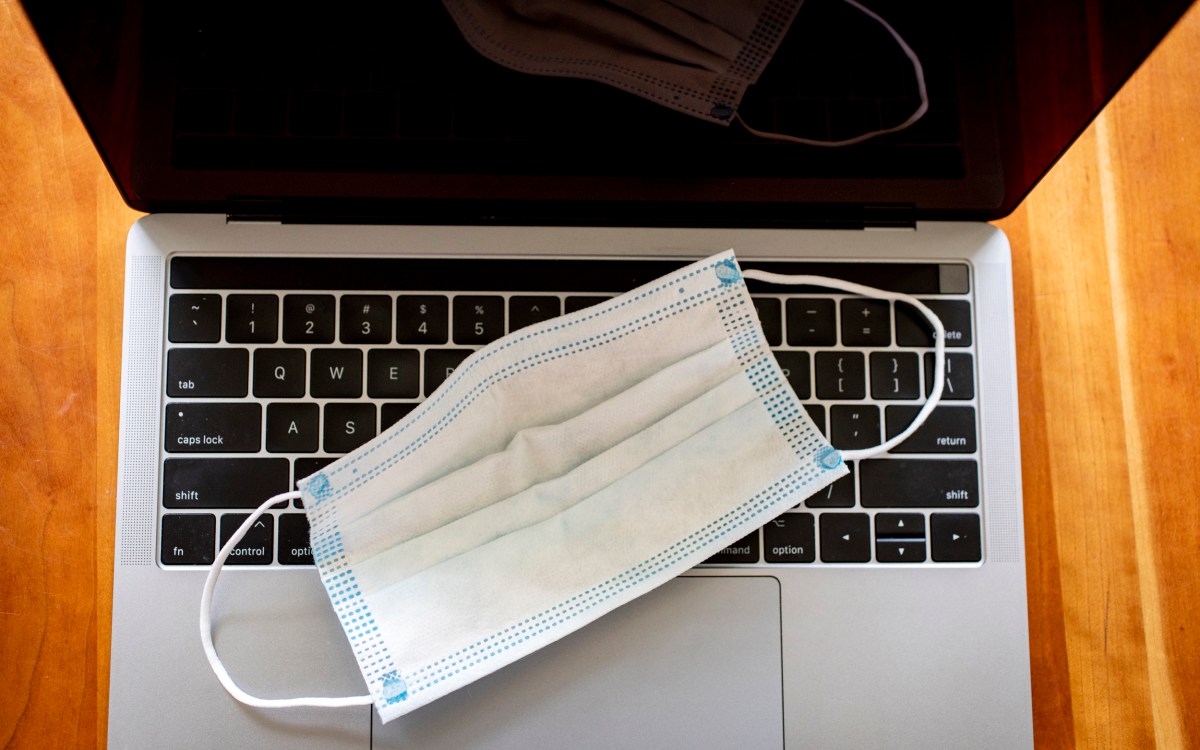
“We have to start preparing doctors for this, meaning in medical school, we have to teach our med students to use telehealth,” said Laura Hoffman (upper left). Joining Hoffman were Blake Reid (clockwise from upper center), Tara Sklar, April Mims, and Mason Marks.
Kris Snibbe/Harvard Staff Photographer
Telehealth works, but upgrade is still needed, say experts
Telehealth showed it can improve access and accessibility, but it must be upgraded, experts say
Telehealth demonstrated its potential value as a way to supplement medical care during the pandemic, greatly improving access and accessibility, and is likely here to stay. But, experts said at a panel this week, changes in regulatory oversight and technological upgrades will be needed to ensure that the already marginalized — the elderly, the poor, the disabled among them — aren’t left further behind.
“Telehealth will be as successful as it is accessible to our most vulnerable populations,” said Laura Hoffman, a senior research fellow at Yale Law School’s Solomon Center for Health Law and Policy. “We have the potential to end up creating a doubling of health care disparities in the United States if we don’t properly address those needs.”
Hoffman was part of an online discussion about the benefits and potential pitfalls of telehealth sponsored by Harvard Law School’s Petrie-Flom Center for Health Law Policy, Biotechnology, and Bioethics. The Wednesday event included advocates for the disabled, representatives of a telehealth company, and experts in health law and policy.
There has been a major expansion of telehealth visits since the pandemic began, taking it from what moderator Mason Marks, a fellow at the Edmond J. Safra Center for Ethics, described as a “fringe” technology that provided less than 1 percent of primary care visits by Medicare beneficiaries in February 2020, to nearly half of primary care visits in April 2020, according to Tara Sklar, professor of health law at the University of Arizona.
“Telehealth has so much promise. But unless we can make all these tools accessible to more people, we’re not going to fully deliver on the promise of telehealth.”
April Mims
That rapid growth was driven by need. The coronavirus pandemic forced restrictions on physician office visits as it did a host of other services in society. But people still needed care and medical advice. It turned out that much of that could be provided remotely, with the option of following up initial visits with in-person care.
Panelists agreed that it’s unlikely that the telehealth genie will go back into its bottle as the pandemic eases, and, as long as steps are taken to ensure access for all, protect privacy, and provide regulatory oversight, that is likely to be a positive development. Robust telehealth practices across the country — functioning as a supplement to necessary in-person care — will make it easier for those who skip doctor visits because of difficulty traveling to and from an office or clinic, perhaps because of limits on time off from work, or for those who live in rural areas far from medical care, or whose ability to move is restricted, or who have psychological conditions such as anxiety or emerging cognitive difficulties and for whom talking with a physician or counselor from the privacy of their own homes is a benefit.
“The opportunity to provide quality care is immense,” said April Mims, vice president of public policy for Hims and Hers, a three-year-old, direct-to-consumer telehealth and wellness platform that has expanded from its original focus on sexual health, skin care, and hair loss to also provide primary care, mental health care, and COVID-19 testing services. “Telehealth has so much promise. But unless we can make all these tools accessible to more people, we’re not going to fully deliver on the promise of telehealth.”
Mims said telehealth provides consumers with greater choice, through access to providers physically distant if they want, for example, a physician of color or one who is LGBTQ. She said the company regularly polls customer satisfaction and is finding that customers are “extremely happy with their experience,” while only 34 percent say they’re satisfied with traditional care.
Panelists agreed, however, that it’s important to be clear-eyed about the potential drawbacks of telehealth. A key change that enabled the pandemic-era expansion of telehealth was suspension of federal regulations that ensured that the platforms used protected patient privacy. That means privacy concerns should be addressed as the practice becomes permanent, including examining the privacy guarantees of third-party software used in sessions. Platforms for communicating with disabled patients should accommodate disabilities such as hearing and vision impairments, particularly if telehealth becomes required or a standard way for patients to interact with the health care system.
More like this
Among other populations needing accommodation, panelists said, are elderly who may not be tech-savvy and those whose limited resources put a computer or smart phone out of reach.
It’s important as well, panelists said, that experts have a say in legislation and regulation affecting the burgeoning practice, both of which are under consideration in several states and at the federal level. Hoffman said another arena that needs to take telehealth into consideration is the nation’s medical schools, saying she recently read an article written by a doctor warning that the next generation of physicians will emerge into a radically changed telehealth landscape.
“We have to start preparing doctors for this, meaning in medical school, we have to teach our med students to use telehealth,” Hoffman said. “It’s not just technology. How does this transform the patient-provider relationship? What does it mean to have that relationship in terms of doing it virtually instead of it being in person? We are at a very dynamic time.”
Through it all, Mims said, it’s important to recognize that telehealth is in an era of not just expansion but also innovation, and it’s important to ensure that any regulatory regime meant to streamline services, bolster universal access, and protect patient privacy does not also stifle innovation or tie the hands of private companies seeking to create new telehealth products and services. She offered the example of requiring an in-person visit before telehealth care can commence, which she said would be “a huge barrier to access.”
“The answer is not to shut down the technology, because there’s a reason it’s out there, there’s a reason people are utilizing the technology,” Mims said. “It’s because it’s working and it’s filling a gap that was there.”









